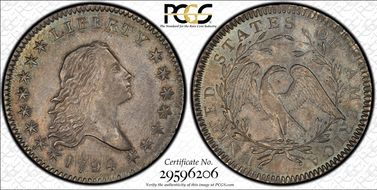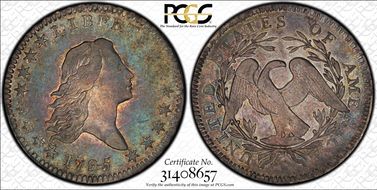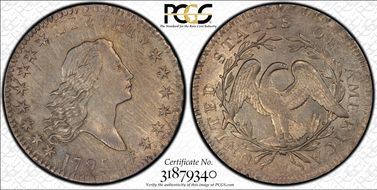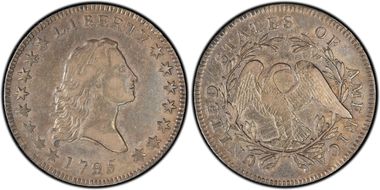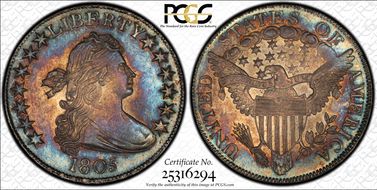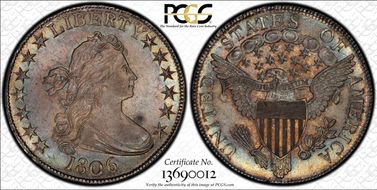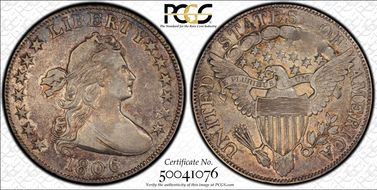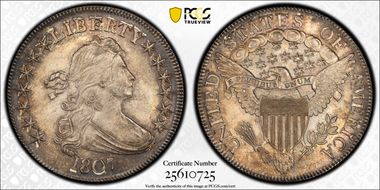The Early American Silver Flowing Hair and Draped Bust Half Dollar Variety Set 的钱币相册
O.129a S/D. Tied Finest Known. . Eliasberg. Pogue. "Provenance: Harlan P. Smith Collection; Henry and S. Hudson Chapman’s sale of the Harlan P. Smith Collection, May 1906, lot 568; John M. Clapp Collection; John H. Clapp, by descent, 1906; John H. Clapp Collection; Clapp Estate; Louis E. Eliasberg, Sr. Collection, via Stack’s, 1942; Richard A. Eliasberg, by descent, 1976; Bowers and Merena’s sale of the Louis E. Eliasberg, Sr. Collection, April 1997, lot 1671." Obtained from Stacks Bowers Auction of the D. Brent Pogue Collection on May 19, 2015, Lot 1097.
O.112 R4. Gardner. Very tough and difficult variety to find in high grade. Second finest known for the die marriage. "Laborers at the Philadelphia Mint adjusted the planchet of this piece before it was struck, and the coinage operation failed to obliterated those crisscross file marks. Both sides show nearly full luster under delicate champagne toning. A few post-strike blemishes are minor," per cataloger. Crossed from NGC AU58 to PCGS AU55 on February 23, 2015. Heritage Auction #1214 of the Eugene Gardner Collection on October 27, 2014, Lot 98458.
O-126a R4+. Small Head. Per cataloger, "Ex: House of Davis McKinney. The diagonal die crack through the E in UNITED is diagnostic for the scarce O-126a. The Small Head subtype is limited to three die marriages, O-126 through O-128, and is a challenging Guide Book acquisition. This golden-brown and apple-green Choice VF half dollar is remarkably unabraded and offers exceptional eye appeal for its designated grade. The eagle's plumage retains hints of mint luster. The central reverse exhibits high-point adjustment marks, as present on the planchet prior to the strike. O-126a Population: 2 in 35, 1 finer (10/15)." Obtained from Heritage Galleries ANA Auction #1231 on January 6, 2015, Lot 3964.
O.113a R4. Eliasberg. Finest Known. Lovely satin finish with strong cartwheel luster of silvery and shimmering surfaces. Private treaty with Legend Numismatics on August 11, 2015.
Eliasberg. O.101 R5+. "Small Eagle. O-101. Rarity-5. 15 Stars. MS-63 (PCGS). OGH. The Eliasberg Choice Mint State 1796 15 Stars Half Dollar. Second Finest Regular Strike Known. Described as Prooflike in our sale of the Eliasberg Collection, both sides of this piece do reveal modest reflectivity in the fields as the surfaces rotate under a light. Otherwise satiny in texture, handsome toning in silver-lilac and olive-russet speaks volumes about this coin's originality. The strike is as close to full as one could realistically expect to see in a Small Eagle Draped Bust half dollar, and there is not so much as a single outwardly distracting abrasion on either side. For provenance confirmation the obverse has faint adjustment marks in Liberty's hair moving from upper left down to lower right, crossing her temple, and the reverse has a small nick below the right (facing) wing, as noted in the recent reference work by Jon P. Amato, Ph.D. titled The Draped Bust Half Dollars of 1796 - 1797 with this specific coin noted on page 47. Two Specimens are noted from these dies, one is the Knoxville specimen, the other is from the Mougey-Granberg-Allenburger-Judd-Walter specimen. The original mintage of this issue is believed to be around 400-600 pieces, with a similar number struck of the sixteen star obverse variety for the recorded total of 934 pieces. Therefore, this issue is one of the rarest regular issue silver coins of the entire mints silver production. Survival rates are low from this early period, and all the known examples have been tracked through auction appearances by Dr. Amato and are carefully researched and presented in his published work. It would be difficult to imagine a much finer example than the present coin, and considering the expanding pursuit of these types of rarities and the classic American coins, we suspect the attention to continue to be focused on these well known rarities for years to come. Here is an opportunity to put away one of the great blue chip coins of American numismatics, and a coin that will instantly be recognized by any knowledgeable collector when presented. Pedigree: Ex: Benjamin H. Collins, January 1896; J.M. Clapp; John H. Clapp; Clapp estate, 1942; Louis E. Eliasberg, Sr.; our sale of the Louis E. Eliasberg, Sr. Collection, April 1997, lot 1673; Heritage's Denver, CO Signature & Platinum Night Auction of August 2006, lot 5222; our Orlando Sale of January 2009, lot 400, unsold; our Treasures from the S.S. New York sale, July 2009, lot 523," per Stack's cataloger. Stacks Bowers Auction The February 2014 Americana Sale - Session 3 on 2/6/2014, Lot 2063.
Eliasberg. O.101 R5+. "Small Eagle. O-101. Rarity-5. 15 Stars. MS-63 (PCGS). OGH. The Eliasberg Choice Mint State 1796 15 Stars Half Dollar. Second Finest Regular Strike Known. Described as Prooflike in our sale of the Eliasberg Collection, both sides of this piece do reveal modest reflectivity in the fields as the surfaces rotate under a light. Otherwise satiny in texture, handsome toning in silver-lilac and olive-russet speaks volumes about this coin's originality. The strike is as close to full as one could realistically expect to see in a Small Eagle Draped Bust half dollar, and there is not so much as a single outwardly distracting abrasion on either side. For provenance confirmation the obverse has faint adjustment marks in Liberty's hair moving from upper left down to lower right, crossing her temple, and the reverse has a small nick below the right (facing) wing, as noted in the recent reference work by Jon P. Amato, Ph.D. titled The Draped Bust Half Dollars of 1796 - 1797 with this specific coin noted on page 47. Two Specimens are noted from these dies, one is the Knoxville specimen, the other is from the Mougey-Granberg-Allenburger-Judd-Walter specimen. The original mintage of this issue is believed to be around 400-600 pieces, with a similar number struck of the sixteen star obverse variety for the recorded total of 934 pieces. Therefore, this issue is one of the rarest regular issue silver coins of the entire mints silver production. Survival rates are low from this early period, and all the known examples have been tracked through auction appearances by Dr. Amato and are carefully researched and presented in his published work. It would be difficult to imagine a much finer example than the present coin, and considering the expanding pursuit of these types of rarities and the classic American coins, we suspect the attention to continue to be focused on these well known rarities for years to come. Here is an opportunity to put away one of the great blue chip coins of American numismatics, and a coin that will instantly be recognized by any knowledgeable collector when presented. Pedigree: Ex: Benjamin H. Collins, January 1896; J.M. Clapp; John H. Clapp; Clapp estate, 1942; Louis E. Eliasberg, Sr.; our sale of the Louis E. Eliasberg, Sr. Collection, April 1997, lot 1673; Heritage's Denver, CO Signature & Platinum Night Auction of August 2006, lot 5222; our Orlando Sale of January 2009, lot 400, unsold; our Treasures from the S.S. New York sale, July 2009, lot 523," per Stack's cataloger. Stacks Bowers Auction The February 2014 Americana Sale - Session 3 on 2/6/2014, Lot 2063.
O.102 R5+. Ex: Reed Hawn and Gene Gardner. Second finest known at PCGS. Per cataloger, "1796 16 Stars Half Dollar, O-102, Boldly Struck MS64. Second-Finest Example at PCGS. A Choice Type Coin. 16 Stars, O-102, High R.5, MS64 PCGS. Amato-201. Whispers of soft tan patina visit the central areas of this lustrous, silver-gray near-Gem, being somewhat more extensive and deeper in hue on the reverse. Bold detail appears on the design elements, including the strands in Liberty's hair and drapery folds, the star centers, the eagle's wing, tail feathers, and claws, the veins in most of the laurel and palm leaves, and the bowknot. Many Mint State Draped Bust Small Eagle half dollars lack this level of design definition. The dentilation is bold throughout and the devices are perfectly centered on the planchet. Occasional contact marks are much fewer and far less severe than expected for the MS64 grade. Indeed, we might surmise that the adjustment marks (frequently seen on early silver and gold coins) in the central reverse may well preclude full Gem classification. Whatever the case, 1796-1797 halves in this level of preservation are infrequently seen and cause significant excitement when they appear at auction. Variety: O-102, High R.5. The 1796 Draped Bust, Small Eagle half dollars display either 15 or 16 obverse stars. Mint records do not indicate the number of 15-Star versus 16-Star examples that were minted. Our ongoing research on this series has documented, however, the existence of 77 examples of the former variety and 64 of the latter. From a statistical standpoint, it might therefore be assumed that fewer 1796 16-Star coins were produced than 1796 15-Star specimens. Population Data (4/15): This is the second finest 1796 16-Star coin seen by PCGS, behind an MS66. NGC reports no near-Gems, but two in MS65. Heritage Commentary: The two-year design type Draped Bust Small Eagle half dollar is a "must-have" coin in order to complete an advanced type set of U.S. coinage. Only 3,918 examples of the type were struck in 1796 and 1797, making it by far the most elusive single U.S. silver type coin. This high-Mint State example of the 1796 O-102 will be a significant hallmark of any advanced type set or denomination collection. Provenance: Dr. C.A. Allenburger Collection (B. Max Mehl's Royal Sale, 3/1948), lot 386; Reed Hawn Collection (Stack's, 8/1973), lot 7; Bowers and Merena (8/1998), lot 181; Superior (8/2002), lot 943; Haig Koshkarian Collection (American Numismatic Rarities, 3/2004), lot 575; Robert Michael Prescott Collection (American Numismatic Rarities, 1/2006), lot 527; Goldberg Auctions (5/2006), lot 2908; Goldberg Auctions (2/2009), lot 927; Goldberg Auctions (1/2011), lot 1413." Obtained from Heritage Auction #1228 of the Eugene Gardner Collection on May 12, 2015, Lot 98349.
O.102 R5+. Ex: Reed Hawn and Gene Gardner. Second finest known at PCGS. Per cataloger, "1796 16 Stars Half Dollar, O-102, Boldly Struck MS64. Second-Finest Example at PCGS. A Choice Type Coin. 16 Stars, O-102, High R.5, MS64 PCGS. Amato-201. Whispers of soft tan patina visit the central areas of this lustrous, silver-gray near-Gem, being somewhat more extensive and deeper in hue on the reverse. Bold detail appears on the design elements, including the strands in Liberty's hair and drapery folds, the star centers, the eagle's wing, tail feathers, and claws, the veins in most of the laurel and palm leaves, and the bowknot. Many Mint State Draped Bust Small Eagle half dollars lack this level of design definition. The dentilation is bold throughout and the devices are perfectly centered on the planchet. Occasional contact marks are much fewer and far less severe than expected for the MS64 grade. Indeed, we might surmise that the adjustment marks (frequently seen on early silver and gold coins) in the central reverse may well preclude full Gem classification. Whatever the case, 1796-1797 halves in this level of preservation are infrequently seen and cause significant excitement when they appear at auction. Variety: O-102, High R.5. The 1796 Draped Bust, Small Eagle half dollars display either 15 or 16 obverse stars. Mint records do not indicate the number of 15-Star versus 16-Star examples that were minted. Our ongoing research on this series has documented, however, the existence of 77 examples of the former variety and 64 of the latter. From a statistical standpoint, it might therefore be assumed that fewer 1796 16-Star coins were produced than 1796 15-Star specimens. Population Data (4/15): This is the second finest 1796 16-Star coin seen by PCGS, behind an MS66. NGC reports no near-Gems, but two in MS65. Heritage Commentary: The two-year design type Draped Bust Small Eagle half dollar is a "must-have" coin in order to complete an advanced type set of U.S. coinage. Only 3,918 examples of the type were struck in 1796 and 1797, making it by far the most elusive single U.S. silver type coin. This high-Mint State example of the 1796 O-102 will be a significant hallmark of any advanced type set or denomination collection. Provenance: Dr. C.A. Allenburger Collection (B. Max Mehl's Royal Sale, 3/1948), lot 386; Reed Hawn Collection (Stack's, 8/1973), lot 7; Bowers and Merena (8/1998), lot 181; Superior (8/2002), lot 943; Haig Koshkarian Collection (American Numismatic Rarities, 3/2004), lot 575; Robert Michael Prescott Collection (American Numismatic Rarities, 1/2006), lot 527; Goldberg Auctions (5/2006), lot 2908; Goldberg Auctions (2/2009), lot 927; Goldberg Auctions (1/2011), lot 1413." Obtained from Heritage Auction #1228 of the Eugene Gardner Collection on May 12, 2015, Lot 98349.
O-101a R5+. CAC. Reed. Third Finest Known 1797. Per Heritage Cataloger, "Gorgeous MS64. Well-Struck, Remarkably Clean Surfaces. From the Byron Reed Collection . 1797 50C O-101a, High R.4, MS64 PCGS Secure. CAC. Amato-401. The Byron Reed Pedigree. The near-Gem PCGS Secure, CAC 1797 O-101a example being offered in this sale is from the Byron Reed Collection. The last auction appearance of this piece occurred in the October 8 and 9, 1996 sale conducted in New York by Spink America/Christie's, in which a portion of Reed's American coins and manuscripts were "Sold by the City of Omaha to Benefit the Western Heritage Museum." The following information on Reed's entrepreneurial, civic, and numismatic exploits is derived from the Spink America/Christie's catalog. Numismatic Background and Census. Physical Description. Both sides of this gorgeous near-Gem example display mirrorlike fields and lightly frosted motifs, each of which possesses shades of soft sky-blue, rose, violet, and gold-orange patination. Only Uncirculated examples display the network of reverse die cracks that occur on this die state; many, if not most of these cracks are worn off on circulated coins, even on XF and AU specimens. On the current Mint State piece, close inspection reveals the presence of the crack through the top of ES in STATES that extends into the field. This is significant because this crack is the very first to appear on the initial reverse die used to coin Draped Bust Small Eagle half dollars, and its appearance occurred when the present reverse was paired with the 1796 15 Stars obverse, not later as suggested by previous numismatic researchers. The second crack to develop on this reverse also shows clearly. It travels from the rim through the right side of O in OF through the palm wreath to the eagle's wing. It also first developed when this reverse was paired with the 1796 15 Stars obverse, not with the 1796 16 Stars obverse per Overton or the 1797 O-101 obverse per Beistle. Some other cracks are not present, suggesting that the reverse of this particular coin has not yet reached its terminal stage. This is further evidenced by the lack of the crack through the bottom of ST in STATES that will eventually intersect the crack from the rim at 9:30, indicating the terminal die state. To summarize, the present coin exudes great technical quality and aesthetic appeal, affirmed by the CAC endorsement. In the opinion of this cataloger (JPA), PCGS may well have been conservative in its numerical grading of this coin. The Byron Reed Collection (Spink America/Christie's, 10/1996), lot 25." Previously sold in Heritage Auction CSNS on 4/23/2015, Lot 5071 for $493,500. Obtained by private treaty with Kagins on January 21, 2016.
O.101 R3. CAC. Ex: Gardner. Obtained by private treaty with carter Numismatics on January 8, 2015.
O.101 R3. CAC. Ex: Gardner. Obtained by private treaty with carter Numismatics on January 8, 2015.
O.101 R3. CAC. Only die marriage for this important year. "The first half dollars coined at Philadelphia appeared late in 1794, with a large production the following year, continuing the original Flowing Hair design. Gilbert Stuart's Draped Bust concept appeared on half dollars in 1796 and 1797, featuring a Small Eagle reverse, and those coins are quite rare. After a brief intermission, the Draped Bust design resumed with a Heraldic Eagle reverse in 1801, and continued through early 1807, skipping coinage dated 1804. The first two issues, 1801 and 1802, are the key dates of that short lived design type. Only a single variety is known for 1802, and Mint records indicate a production of 29,890 coins. Based on the number of survivors, it is quite likely that that figure represents the true mintage of 1802-dated half dollars. This example shows faded clash marks on the reverse, although there is no discussion of die states in the Overton reference. It is perhaps surprising that the dies for this single variety were apparently not used in 1803, based on the number of surviving specimens. Perhaps 700 to 800 examples survive in all grades, and high-grade examples are quite rare. The combined PCGS and NGC population data shows 287 examples in all grades with an average grade of VF30. There are just 10 certification events in AU58, and only three finer submissions (7/13). This lovely near-Mint specimen has flashes of brilliant mint luster around the protected areas, visible through the lovely gold, blue and iridescent toning on each side. The strike is bold and the eye appeal is exceptional. Here is an important opportunity for the advanced early half dollar specialist. Population: 7 in 58, 2 finer (7/13)," per Heritage cataloger. Heritage Auction Platinum Night #1188 on 8/9/2013, Lot 5633.
O.101 R3. CAC. Only die marriage for this important year. "The first half dollars coined at Philadelphia appeared late in 1794, with a large production the following year, continuing the original Flowing Hair design. Gilbert Stuart's Draped Bust concept appeared on half dollars in 1796 and 1797, featuring a Small Eagle reverse, and those coins are quite rare. After a brief intermission, the Draped Bust design resumed with a Heraldic Eagle reverse in 1801, and continued through early 1807, skipping coinage dated 1804. The first two issues, 1801 and 1802, are the key dates of that short lived design type. Only a single variety is known for 1802, and Mint records indicate a production of 29,890 coins. Based on the number of survivors, it is quite likely that that figure represents the true mintage of 1802-dated half dollars. This example shows faded clash marks on the reverse, although there is no discussion of die states in the Overton reference. It is perhaps surprising that the dies for this single variety were apparently not used in 1803, based on the number of surviving specimens. Perhaps 700 to 800 examples survive in all grades, and high-grade examples are quite rare. The combined PCGS and NGC population data shows 287 examples in all grades with an average grade of VF30. There are just 10 certification events in AU58, and only three finer submissions (7/13). This lovely near-Mint specimen has flashes of brilliant mint luster around the protected areas, visible through the lovely gold, blue and iridescent toning on each side. The strike is bold and the eye appeal is exceptional. Here is an important opportunity for the advanced early half dollar specialist. Population: 7 in 58, 2 finer (7/13)," per Heritage cataloger. Heritage Auction Platinum Night #1188 on 8/9/2013, Lot 5633.
O.104 R.3. CAC. Reed Hawn. Pogue. Finest Known 1803 Small 3 Half Dollar. Flashy cartwheel luster and lovely original surfaces result in very strong eye appeal. Per Pogue cataloger, "The Single Best 1803 Small 3 Half Dollar. The Reed Hawn Coin. Alone atop the Condition Census. A specimen of extraordinary elegance and freshness, whose quality stands out even among the coins of the D. Brent Pogue Collection. The toning framing the obverse changes, chameleon-like, from gold to sea-green and blue as the intense cartwheel luster collects light and slides around the perimeter. The center is soft lavender and gray with hints of blue. The bright blue around the reverse also seems to collect and magnify the lustrous cartwheel, framing the pale violet and gold center. Luster defines this piece, giving it a special level of aesthetic appeal. A few natural planchet streaks are seen, a by-product of an impurity in the Mint’s silver ingot that became a striation when rolled; the most significant is near Liberty’s chin, with others parallel. No significant marks or lines are found. The strike is soft at the lowest curl, the eagle’s head, and the star cluster above it, but the definition in Liberty’s portrait and hair, the eagle’s wings, and other areas more than makes up for it. The “large and flat” stars described by Overton are mostly absent here, as every star has some central detail and most have all of it. Some delicate die cracks are seen, including one from Liberty’s hair near its highest wave to near the base of E and another through T of LIBERTY to Liberty’s forehead below. A reverse crack begins at the top of the first S in STATES, undulates along the curves of that letter, then arcs to the rim through the clouds and finally through the last S of STATES. This is the only recorded candidate for finest known honors of this major variety. The Queller Family - Gene Gardner coin, the next closest competitor, is graded MS-62 (PCGS). It is the only other example certified as Mint State by PCGS. A previous offering of this coin misinterpreted its provenance, creating a seeming challenger where there was none. The Pogue example maintains its unquestioned primacy among all examples of the Small 3 variety. Provenance: Pogue. Reed Hawn Collection. Stack’s sale of the Reed Hawn Collection of United States Coins, August 1973, lot 12; Dr. George F. Oviedo, Jr. Collection; Stack’s sale of the Dr. George F. Oviedo, Jr. Collection of U.S. Half Dollars, September 1983, lot 731; Stack’s session of Auction ’87, July 1987, lot 745; Superior Galleries’ sale of the Worrell Collection of United States Coinage, September 1993, lot 1262; Stack’s Orlando Sale, January 2009, lot 409; Larry Hanks, by sale, January 7, 2009." Obtained from Stacks Bowers Auction of the D. Brent Pogue Collection on May 19, 2015, Lot 1108.
O-116. R.3. CAC. Per cataloger, "Pointed 6, Stem, O-116, R.3, MS65+ PCGS. CAC. O-116 is one of the more plentiful Pointed 6, Stem through claw varieties, though it is noted that any variety of this issue is elusive in Mint State and decidedly rare at the Gem grade level. This variety exhibits the third of four uses for this obverse and one of three uses for this reverse. The obverse is extensively cracked around the periphery from the tip of the bust, through the date, all the way to the R in LIBERTY. This die began cracking early in its second marriage (O-115), and was finally retired after striking a number of O-117 coins. The TY in LIBERTY are recut, though the evidence is not as distinctive on this late die state as it is on early varieties. This reverse die was also briefly paired with obverses 11 and 13, producing the extremely rare O-128 and O-129 varieties. It is seen here in a late state, with a peripheral crack from below the eagle's tailfeathers, though the top of UNITED, and terminating by the second S in STATES. Examples of this variety are seldom available in Mint State, and at the Gem level it is a major rarity for the Draped Bust type. The PCGS certified population of all Pointed 6, With Stem varieties is just eight coins in MS65 (2 in 65+), with only four numerically finer (11/14). This dazzlingly lustrous example showcases sea-green, olive, and lavender-gold hues over each side, with a few deeper amber accents also seen in localized areas of the recesses. A few tiny ticks in the right obverse field are seemingly all that keep this Plus-designated piece from a full Premium Gem grade. Light die lapping is evident on the hair curls by Liberty's forehead, also the primary cause of the recutting on the TY in LIBERTY slowly fading. This lapping is much more extensive on later states of this obverse, mostly seen on the O-117 variety, its final usage. The reverse is lightly clashed. Whether for type, date, or variety purposes, this high-end Gem is an ideal representative of the O-116 variety, showcasing a degree of eye appeal that is not often seen on any half dollar from this period. An impressive and important coin in every respect. The specialist should bid accordingly." Obtained from Heritage FUN Platinum Night Auction #1216 on 1/7/2015, Lot 4125.
O-116. R.3. CAC. Per cataloger, "Pointed 6, Stem, O-116, R.3, MS65+ PCGS. CAC. O-116 is one of the more plentiful Pointed 6, Stem through claw varieties, though it is noted that any variety of this issue is elusive in Mint State and decidedly rare at the Gem grade level. This variety exhibits the third of four uses for this obverse and one of three uses for this reverse. The obverse is extensively cracked around the periphery from the tip of the bust, through the date, all the way to the R in LIBERTY. This die began cracking early in its second marriage (O-115), and was finally retired after striking a number of O-117 coins. The TY in LIBERTY are recut, though the evidence is not as distinctive on this late die state as it is on early varieties. This reverse die was also briefly paired with obverses 11 and 13, producing the extremely rare O-128 and O-129 varieties. It is seen here in a late state, with a peripheral crack from below the eagle's tailfeathers, though the top of UNITED, and terminating by the second S in STATES. Examples of this variety are seldom available in Mint State, and at the Gem level it is a major rarity for the Draped Bust type. The PCGS certified population of all Pointed 6, With Stem varieties is just eight coins in MS65 (2 in 65+), with only four numerically finer (11/14). This dazzlingly lustrous example showcases sea-green, olive, and lavender-gold hues over each side, with a few deeper amber accents also seen in localized areas of the recesses. A few tiny ticks in the right obverse field are seemingly all that keep this Plus-designated piece from a full Premium Gem grade. Light die lapping is evident on the hair curls by Liberty's forehead, also the primary cause of the recutting on the TY in LIBERTY slowly fading. This lapping is much more extensive on later states of this obverse, mostly seen on the O-117 variety, its final usage. The reverse is lightly clashed. Whether for type, date, or variety purposes, this high-end Gem is an ideal representative of the O-116 variety, showcasing a degree of eye appeal that is not often seen on any half dollar from this period. An impressive and important coin in every respect. The specialist should bid accordingly." Obtained from Heritage FUN Platinum Night Auction #1216 on 1/7/2015, Lot 4125.
O-116. R.3. CAC. Per cataloger, "Pointed 6, Stem, O-116, R.3, MS65+ PCGS. CAC. O-116 is one of the more plentiful Pointed 6, Stem through claw varieties, though it is noted that any variety of this issue is elusive in Mint State and decidedly rare at the Gem grade level. This variety exhibits the third of four uses for this obverse and one of three uses for this reverse. The obverse is extensively cracked around the periphery from the tip of the bust, through the date, all the way to the R in LIBERTY. This die began cracking early in its second marriage (O-115), and was finally retired after striking a number of O-117 coins. The TY in LIBERTY are recut, though the evidence is not as distinctive on this late die state as it is on early varieties. This reverse die was also briefly paired with obverses 11 and 13, producing the extremely rare O-128 and O-129 varieties. It is seen here in a late state, with a peripheral crack from below the eagle's tailfeathers, though the top of UNITED, and terminating by the second S in STATES. Examples of this variety are seldom available in Mint State, and at the Gem level it is a major rarity for the Draped Bust type. The PCGS certified population of all Pointed 6, With Stem varieties is just eight coins in MS65 (2 in 65+), with only four numerically finer (11/14). This dazzlingly lustrous example showcases sea-green, olive, and lavender-gold hues over each side, with a few deeper amber accents also seen in localized areas of the recesses. A few tiny ticks in the right obverse field are seemingly all that keep this Plus-designated piece from a full Premium Gem grade. Light die lapping is evident on the hair curls by Liberty's forehead, also the primary cause of the recutting on the TY in LIBERTY slowly fading. This lapping is much more extensive on later states of this obverse, mostly seen on the O-117 variety, its final usage. The reverse is lightly clashed. Whether for type, date, or variety purposes, this high-end Gem is an ideal representative of the O-116 variety, showcasing a degree of eye appeal that is not often seen on any half dollar from this period. An impressive and important coin in every respect. The specialist should bid accordingly." Obtained from Heritage FUN Platinum Night Auction #1216 on 1/7/2015, Lot 4125.
O-109. R.1. CAC. Pogue. Per Pogue cataloger, "Gem 1806 Pointed 6, No Stem Half Dollar. Finest Graded by PCGS. 1806 Draped Bust Half Dollar. Overton-109. Rarity-1. Pointed 6, No Stem. MS-65 (PCGS). “No stem to olive branch through eagle’s claw; extremely rare variety.” — J. Colvin Randall, 1881. Astoundingly beautiful and well preserved, a thrilling gem specimen. The cartwheel luster is almost beyond the bounds of the believable, and the strike is similarly fine. Each star on the right side of the obverse shows full raised central detail, as do nearly all of the stars among the reverse star cluster. Each eagle feather from chest to wingtip shows its full complement of graver strokes, a manifestation of the engraver’s ideal. The clouds are rounded and the denticles are sharp. Even the raised lathe lines at the central obverse are clear. Over this precise strike is superior toning, with bright gold at the rims embracing a frosty gray center that incorporates shades of violet and blue. The reverse is even more decorative and colorful, showing orange and brighter blue. A speck of residue persists inside star 11, and another piece of detritus is seen between the hair ribbon and stars, but no notable marks are found with a glass. A spot of deeper toning is harmless, just above the bust. Two clashes are seen on the obverse above the date, but evidence of only one impression is seen on the reverse, noted only between the wingtip and OF. Only two varieties of 1806 half dollars use a reverse with no stem through the eagle’s claw, this one and the extremely rare O-108, as offered in the previous lot. Though a fair number are known in nice grade, including more than a dozen in lower Mint State grades, this is the only Gem MS-65 to have been certified by PCGS. This variety appears to have been first published in the so-called “Haseltine Type Table,” an 1881 auction by John Haseltine that was published as a monograph, thereafter serving as the first listing of die varieties of quarter dollars, half dollars, and silver dollars. The collection was built by J. Colvin Randall, a Philadelphia numismatist, and it was Randall who wrote the Type Table, despite Haseltine’s claims of authorship. Randall owned a specimen he called Uncirculated (perhaps this specimen?). His idea that the variety was extremely rare has been modified by later discoveries, as collecting half dollars by variety has become a popular pastime in the 20th and 21st centuries. This would be an unimproveable addition to a collection focusing on early half dollar varieties or any cabinet where fine and original early 19th century U.S. coins are being assembled. PCGS Population: 1, none finer. (Pointed 6, no stem; O-109). Provenance: Purchased at the Whitman Coin & Collectibles Expo in Baltimore, Maryland in November 200Obtained from Stacks bowers Auction of the D. Bent Pogue Collection Part 1, May 19, 2015, Lot 1113.
O-108. R.7. CAC. Pogue. Per cataloger, "The Finest Known 1806 Knobbed 6, No Stem Half Dollar. A Famous Rarity, Just Seven Known. 1806 Draped Bust Half Dollar. Overton-108. Rarity-7. Knobbed 6, No Stem. EF-40 (PCGS). “A naked-eye type, comparable in importance to the 1817/14 overdate.” — Walter Breen, 1970. One of the most famous rarities in the American half dollar series, an extremely rare variety of which this is likely the finest identified specimen. Just seven examples are known, ranging from EF (this coin and only this coin) to Very Good, with a mean grade of Fine. The surfaces are lightly toned over light silver gray, still somewhat bright in protected areas. The eye appeal is good for the grade, and the surfaces show no heavy marks or damage. Some minor hairlines are seen, to be expected of a coin of this quality, along with a smattering of fine contact marks commensurate with the level of wear. A fine planchet striation manifests as minor granularity under D of UNITED, parallel to another from U to the arrow claw. The strike, as on all specimens known, shows areas of significant softness. Liberty’s chest is devoid of detail, as are clouds 6 and 7 and the nearest stars. No die cracks are noted on obverse or reverse. A major variety that has been sought by cherrypickers since its discovery in 1951, decades of laborious searching have not yielded more than a handful of survivors, despite the ease of attribution from arm’s length. Discovered by Walter Breen in 1951, this variety combines an obverse type and a reverse type that are found on other varieties, namely an obverse with the 6 in the date knobbed instead of pointed, and a reverse that shows no stem of the olive branch below the eagle’s claw. Other Knobbed 6 varieties are common, as are other No Stem Through Claw varieties; together, they combine to make a famed rarity. Despite the fact that dedicated specialists have searched high and low for this variety ever since Breen published it, few have been found. The condition of the reverse die likely condemned this marriage to an early end, as at least two of the survivors are broken heavily over UNITED. The only other example of this major variety to have sold in the last 15 years was graded just Fine and showed heavy scratches; nonetheless, it brought $25,300 in 2008. PCGS Population: 1, none finer. (Knob 6, no stem; O-108). Provenance: Bought in El Paso, Texas in 1979 for $375; Bowers and Merena’s American Numismatic Association sale, July 2003, lot 1395 (at $86,250); Stack’s Orlando sale, January 2009, lot 416; Larry Hanks, by sale, January 7, 2009." Obtained from Stacks Bowers Auction of the D. Brent Pogue Collection Part 1 on may 19, 2015, Lot 1112.
O.106. R.4. CAC. Gardner. Quellar. Finest Known. Per cataloger, "Knob 6, Small Stars, R.4. The Queller Specimen, Finest Known. Knob 6, Small Stars, O-106, R.4, MS63 PCGS. CAC. This impressive medium steel specimen features accents of pale golden-rose, lime-green, and sky-blue toning, especially along the peripheries. A trivial dark toning spot in the lower-left obverse field will aid future pedigree research. Otherwise, the surfaces reveal only minuscule surface marks when a glass is used. A remarkable specimen, this piece is destined for an advanced collection of early half dollars -- as it was earlier in the remarkable collection of the late David Queller. Variety: O-106, R.4. The obverse of this very scarce variety shows a Knob 6 and recut 8, and the reverse has six berries in the branch, the lowest inside berry faintly visible. The obverse is lightly cracked through the tops of LIBERTY to the upper stars at left and right. A faint crack joins the date digits. The reverse is perfect. The strike is weak at the drapery and among the stars and clouds opposite the drapery, characteristic of this variety and several others in the series. Population Data (4/15): All varieties included, PCGS enumerates only two Knob 6, Small Stars 1806 halves in Mint State grades, of which the current O-106 example is the finer by three grade points. NGC has attributed no examples of this subtype finer than a single AU58. Heritage Commentary: This attractive specimen is easily the finest-known O-106 example, the only Mint State piece recorded in Stephen Herrman's Auction & Mail Bid Prices Realized for Bust Half Dollars 1794-1839. Another piece appearing in the Stack's October 1996 sale is listed as MS65 and finest known, but Stack's misattributed the coin as O-106 when it is actually O-109. Provenance: Stack's (privately, April 1979); Queller Family Collection (Stack's, 10/2002), lot 49; Gary Adkins (12/2002); later, Stack's (11/2011), lot 2247; ANA Signature (Heritage, 10/2012), lot 4295." Obtained from Heritage Auction #1228 of the Eugene Gardner Collection III on may 12, 2015, Lot 98443.
O.106. R.4. CAC. Gardner. Quellar. Finest Known. Per cataloger, "Knob 6, Small Stars, R.4. The Queller Specimen, Finest Known. Knob 6, Small Stars, O-106, R.4, MS63 PCGS. CAC. This impressive medium steel specimen features accents of pale golden-rose, lime-green, and sky-blue toning, especially along the peripheries. A trivial dark toning spot in the lower-left obverse field will aid future pedigree research. Otherwise, the surfaces reveal only minuscule surface marks when a glass is used. A remarkable specimen, this piece is destined for an advanced collection of early half dollars -- as it was earlier in the remarkable collection of the late David Queller. Variety: O-106, R.4. The obverse of this very scarce variety shows a Knob 6 and recut 8, and the reverse has six berries in the branch, the lowest inside berry faintly visible. The obverse is lightly cracked through the tops of LIBERTY to the upper stars at left and right. A faint crack joins the date digits. The reverse is perfect. The strike is weak at the drapery and among the stars and clouds opposite the drapery, characteristic of this variety and several others in the series. Population Data (4/15): All varieties included, PCGS enumerates only two Knob 6, Small Stars 1806 halves in Mint State grades, of which the current O-106 example is the finer by three grade points. NGC has attributed no examples of this subtype finer than a single AU58. Heritage Commentary: This attractive specimen is easily the finest-known O-106 example, the only Mint State piece recorded in Stephen Herrman's Auction & Mail Bid Prices Realized for Bust Half Dollars 1794-1839. Another piece appearing in the Stack's October 1996 sale is listed as MS65 and finest known, but Stack's misattributed the coin as O-106 when it is actually O-109. Provenance: Stack's (privately, April 1979); Queller Family Collection (Stack's, 10/2002), lot 49; Gary Adkins (12/2002); later, Stack's (11/2011), lot 2247; ANA Signature (Heritage, 10/2012), lot 4295." Obtained from Heritage Auction #1228 of the Eugene Gardner Collection III on may 12, 2015, Lot 98443.
O-111a R.3. CAC. Norweb and Green. Per cataloger, "Beautiful Tied-For-Finest 1806/Inverted 6 Half Dollar. Ex Collins, Newcomer, Green, Clarke, Norweb, Jewell. Rich lavender-gray surfaces display attractive rose and blue iridescence throughout while abundant underlying luster sparks to life under a light. The central devices are boldly struck with crisp definition seen in Liberty's curls and in the eagle's feathers while the peripheries on the right of both sides display a bit of softness, not at all unusual for the design type. Smooth fields and exceptional eye appeal round out this delightful coin that is sure to please even the most discriminating of collectors, as well it should -- there is simply none finer available! An ever-popular die variety that was long referred to in numismatics as the "1806/9" variety, an incongruous notion that was popular as recently as Breen's 1988 Encyclopedia, though more recent research deems it to be as stated, an 1806/Inverted 6 in date variety.Only three Mint State examples of this popular variety have been certified by PCGS to date, one at MS-61 and two at MS-64, including the gorgeous example offered here, a fact that speaks volumes about the absolute rarity of the variety in Mint State. Indeed, most Mint State Draped Bust half dollars of any date or variety are downright rare in Uncirculated, and nearly all -- "all" comprises a very small group indeed -- were rescued from the ravages of circulation and time as a matter of chance or luck, with only precious few ever saved through actual intention. To those collectors who "rescued" Mint State Draped Bust half dollars in the infancy of coin collecting in America, we doff our collective collector caps! No doubt more than one specialist will have an eye out when this rare beauty crosses the auction block, and we predict the paddles will be held high until the auctioneer's hammer drops. And the "plus" for this lot? You get to add your name to the illustrious list of collections in which this impressive beauty was kept. Pedigree: From the Stephen Winthrop Collection. Acquired from Pinnacle Rarities, October 2005. Earlier ex: B.H. Collins; Waldo C. Newcomer; Col. E.H.R. Green; New Netherlands' sale of the T. James Clarke Collection, April 1965, lot 1204; our (Bowers and Merena's) sale of the Norweb Collection, Part III, November 1988, lot 3042; our (American Numismatic Rarities') Richard Jewell Collection sale, March 2005, lot 1745." Obtained from Stacks bowers Auction on February 6, 2015, Lot 2038.
O-111a R.3. CAC. Norweb and Green. Per cataloger, "Beautiful Tied-For-Finest 1806/Inverted 6 Half Dollar. Ex Collins, Newcomer, Green, Clarke, Norweb, Jewell. Rich lavender-gray surfaces display attractive rose and blue iridescence throughout while abundant underlying luster sparks to life under a light. The central devices are boldly struck with crisp definition seen in Liberty's curls and in the eagle's feathers while the peripheries on the right of both sides display a bit of softness, not at all unusual for the design type. Smooth fields and exceptional eye appeal round out this delightful coin that is sure to please even the most discriminating of collectors, as well it should -- there is simply none finer available! An ever-popular die variety that was long referred to in numismatics as the "1806/9" variety, an incongruous notion that was popular as recently as Breen's 1988 Encyclopedia, though more recent research deems it to be as stated, an 1806/Inverted 6 in date variety.Only three Mint State examples of this popular variety have been certified by PCGS to date, one at MS-61 and two at MS-64, including the gorgeous example offered here, a fact that speaks volumes about the absolute rarity of the variety in Mint State. Indeed, most Mint State Draped Bust half dollars of any date or variety are downright rare in Uncirculated, and nearly all -- "all" comprises a very small group indeed -- were rescued from the ravages of circulation and time as a matter of chance or luck, with only precious few ever saved through actual intention. To those collectors who "rescued" Mint State Draped Bust half dollars in the infancy of coin collecting in America, we doff our collective collector caps! No doubt more than one specialist will have an eye out when this rare beauty crosses the auction block, and we predict the paddles will be held high until the auctioneer's hammer drops. And the "plus" for this lot? You get to add your name to the illustrious list of collections in which this impressive beauty was kept. Pedigree: From the Stephen Winthrop Collection. Acquired from Pinnacle Rarities, October 2005. Earlier ex: B.H. Collins; Waldo C. Newcomer; Col. E.H.R. Green; New Netherlands' sale of the T. James Clarke Collection, April 1965, lot 1204; our (Bowers and Merena's) sale of the Norweb Collection, Part III, November 1988, lot 3042; our (American Numismatic Rarities') Richard Jewell Collection sale, March 2005, lot 1745." Obtained from Stacks bowers Auction on February 6, 2015, Lot 2038.
O-105 R.1. CAC. Tied Finest Known 1807 Draped Bust Half Dollar. Per cataloger, "Second finest at PCGS. High condition census. Tompkins Die State 3/2. A rare, high-end type coin from the final year of the Draped Bust design. The only Draped Bust halves that are marginally available in Mint State for type collectors are the 1806 and 1807, and these are also the only dates in the series that exist in any meaningful quantity -- even if small -- at the Gem level. This Plus-graded 1807 is effectively the sole second-finest at PCGS, and it is a high Condition Census example of the O-105 die pairing. The only finer examples of the variety are an MS66 NGC coin and the D. Brent Pogue MS66 PCGS example (Stack's-Bowers, 5/2015), lot 1115, which realized a strong sum of $152,750. NGC lists one additional MS66 coin, an O-110 example that appeared in our FUN Signature sale (Heritage, 1/2016), lot 5363. This high-end MS65, however, carries the distinction of being one of only two Gems with a CAC endorsement -- something not awarded to any finer example of the variety or date. This piece is also the first PCGS-graded Gem regular-issue 1807 Draped Bust half we have ever offered at auction, even though PCGS lists seven other non-Plus-graded MS65s (2/19). This coin displays a razor-sharp, even strike that defines all peripheral stars and the central reverse eagle and stars. Liberty's portrait is equally bold. This frosty, lustrous coin showcases original mint luster. The interiors have light champagne toning, but the peripheries exhibit deep russet and gunmetal-blue hues that attractively frame the devices. Only a few trivial ticks are seen under a loupe. This die state shows both dies clashed with faint peripheral cracks. Later states of the reverse exhibit advanced deterioration, as this is that die's only use. The obverse was later employed for O-106 and -107. An outstanding coin that is sure to attract competitive bidding when it crosses the auction block. Ex: Highland Collection/Portland ANA (Stack's Bowers, 3/2015), lot 225; Central States Signature (Heritage, 4/2016), lot 4657, which realized $141,000."




















